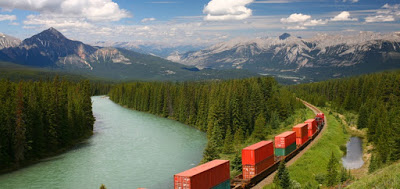The path to real-time visibility in any industry is rarely easy, but in
2019, when an Amazon package can be tracked with every step of the carrier,
you’d think rail customers would be able to find out where their freight is
without making a phone call.
2019, when an Amazon package can be tracked with every step of the carrier,
you’d think rail customers would be able to find out where their freight is
without making a phone call.
The truth is, most can’t, and many don’t find out about problems on the
rails until their freight is late and they call to ask why.
rails until their freight is late and they call to ask why.
So how can the rail industry begin to deploy technologies that leverage
real-time data?
real-time data?
Start with APIs
Application Programming Interfaces (API) are a very simple form of
automation where one server makes a data request for another on a continual
basis, allowing for real-time data.
automation where one server makes a data request for another on a continual
basis, allowing for real-time data.
Though railroads are certainly digitized
today, most of the data flows only based on request from a user, meaning data
isn’t continually updated and generally isn’t a real-time representation of
what’s happening by the time it reaches the customer.
today, most of the data flows only based on request from a user, meaning data
isn’t continually updated and generally isn’t a real-time representation of
what’s happening by the time it reaches the customer.
“APIs have gotten a lot of traction in the truck space but not so
much in the rail space. This is an area that we are actively working
on,” said Shankar Sengupta, the VP of engineering and transport
logistics at GE Transportation.
much in the rail space. This is an area that we are actively working
on,” said Shankar Sengupta, the VP of engineering and transport
logistics at GE Transportation.
The next step after adopting APIs (assuming that all railroads in a
railcar’s path had done so) would be making the data available to customers.
railcar’s path had done so) would be making the data available to customers.
Sengupta suggested using blockchain to do this, but he emphasized it’s not the
only way.
only way.
“Once you start putting that data in a central repository, for now
let’s assume it’s a blockchain in the cloud, everybody can see it and everybody
can take action on it,” he said.
let’s assume it’s a blockchain in the cloud, everybody can see it and everybody
can take action on it,” he said.
Add IoT and sensors
Other than answering the age old question “where’s my
stuff?” real-time visibility can also help with railroads’ number one
priority, which is, in their own words — safety. For this, Internet of Things
(IoT) technology is top of mind in the industry.
stuff?” real-time visibility can also help with railroads’ number one
priority, which is, in their own words — safety. For this, Internet of Things
(IoT) technology is top of mind in the industry.
The Positive Train Control (PTC) mandate made sure railroads were very
familiar with installing lots of sensors and even learning from traffic data,
but there is more to sensors and cameras.
familiar with installing lots of sensors and even learning from traffic data,
but there is more to sensors and cameras.
Canadian National is using LiDAR technology to create 3D images of
tracks and find hairline cracks and defects to speed repairs to ensure safe
operations.
tracks and find hairline cracks and defects to speed repairs to ensure safe
operations.
The railroad also uses cameras and data analytics to inspect
railcars before they head into service.
railcars before they head into service.
CN had to find the right cameras and sensors to measure what is needed
to monitor track maintenance. Some aspects of rail car maintenance are already
available.
to monitor track maintenance. Some aspects of rail car maintenance are already
available.
New railcars come equipped with up to 500 sensors delivering plenty
of data that currently isn’t widely used effectively, according to Timothy
Thompson, senior manager of rail solutions for Uptake Technologies.
of data that currently isn’t widely used effectively, according to Timothy
Thompson, senior manager of rail solutions for Uptake Technologies.
Uptake, a Chicago startup and Supply Chain Dive’s innovator of the
year for 2018, is using data that railcars are already
collecting to predict maintenance and downtime, reducing “road failures” and
increasing reliability.
year for 2018, is using data that railcars are already
collecting to predict maintenance and downtime, reducing “road failures” and
increasing reliability.
Don’t let legacy systems
hold you back
hold you back
The technology to enable real-time visibility of freight location, track
safety and locomotive health is available in the marketplace and in use in
other industries.
safety and locomotive health is available in the marketplace and in use in
other industries.
So what are the barriers to wide adoption in rail? A major
problem that’s shared all over the supply chain: legacy systems.
problem that’s shared all over the supply chain: legacy systems.
“The technology may be there, but culturally we’re not
there,” said Sengupta, who offered the example of ERPs, which he sees
as standing in the way of blockchain adoption and could equally apply to other
forms of cloud computing.
there,” said Sengupta, who offered the example of ERPs, which he sees
as standing in the way of blockchain adoption and could equally apply to other
forms of cloud computing.
“The promise of blockchain is nothing is on your premises. You
trust the cloud.
trust the cloud.
You’re putting everything in the cloud, but you made millions
and millions of dollars of investment in ERPs. Are you ready to throw that
out?,” Sengupta asked.
and millions of dollars of investment in ERPs. Are you ready to throw that
out?,” Sengupta asked.
The solution, he suggested, is a slow conversion.
“For a long time, even if there is a blockchain cloud up in the
sky, we will have to have a hybrid strategy,” he said.
sky, we will have to have a hybrid strategy,” he said.
Then once
real-time visibility is achieved, railroads will have to decide to share the
results with their customers. On this front, Thompson is optimistic.
real-time visibility is achieved, railroads will have to decide to share the
results with their customers. On this front, Thompson is optimistic.
“The trends in rail have been moving toward end customers having
access and utilizing asset data more than in the past,” he said, adding that
data ownership is coming up more often in contract negotiations.
access and utilizing asset data more than in the past,” he said, adding that
data ownership is coming up more often in contract negotiations.
Credit:Supply Chain Dive.

